The final paper on Indo-Iranian peoples, by Narasimhan and Patterson (see preprint), is soon to be published, according to the first author’s Twitter account.
One of the interesting details of the development of Bronze Age Iberian ethnolinguistic landscape was the making of Proto-Iberian and Proto-Basque communities, which we already knew were going to show R1b-P312 lineages, a haplogroup clearly associated during the Bell Beaker period with expanding North-West Indo-Europeans:
From the Bronze Age (~2200–900 BCE), we increase the available dataset from 7 to 60 individuals and show how ancestry from the Pontic-Caspian steppe (Steppe ancestry) appeared throughout Iberia in this period, albeit with less impact in the south. The earliest evidence is in 14 individuals dated to ~2500–2000 BCE who coexisted with local people without Steppe ancestry. These groups lived in close proximity and admixed to form the Bronze Age population after 2000 BCE with ~40% ancestry from incoming groups. Y-chromosome turnover was even more pronounced, as the lineages common in Copper Age Iberia (I2, G2, and H) were almost completely replaced by one lineage, R1b-M269.
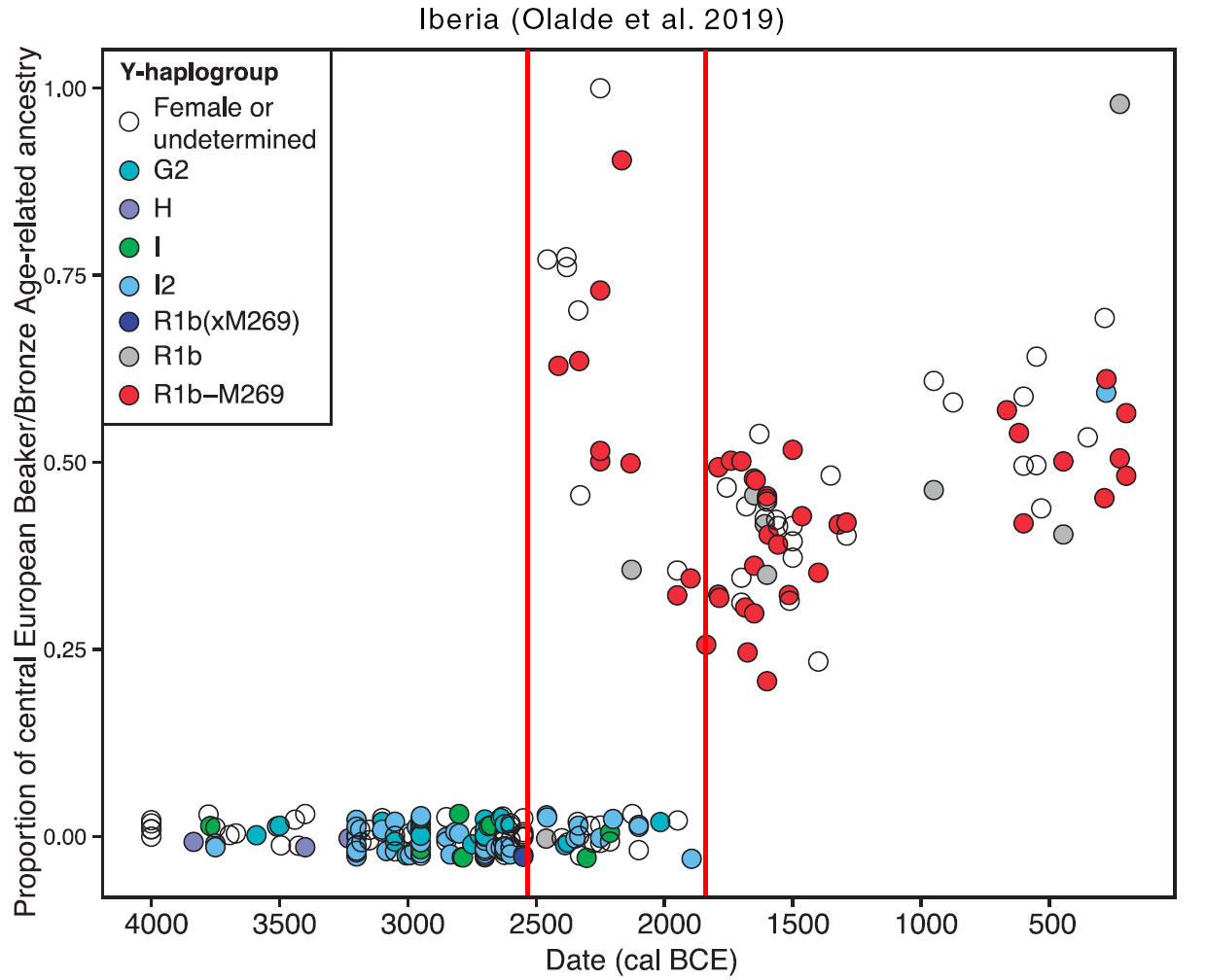
The arrival of East Bell Beakers speaking Indo-European languages involved, nevertheless, the survival of the two non-IE communities isolated from each other – likely stemming from south-western France and south-eastern Iberia – thanks to a long-lasting process of migration and admixture. There are some common misconceptions about ancient languages in Iberia which may have caused some wrong interpretations of the data in the paper and elsewhere:
NOTE. A simple reading of Iberian prehistory would be enough to correct these. Two recent books on this subject are Villar’s Indoeuropeos, iberos, vascos y otros parientes and Vascos, celtas e indoeuropeos. Genes y lenguas.
Iberian languages were spoken at least in the Mediterranean and the south (ca. “1/3 of Iberia“) during the Bronze Age.
Nope, we only know the approximate location of Iberian culture and inscriptions from the Late Iron Age, and they occupy the south-eastern and eastern coastal areas, but before that it is unclear where they were spoken. In fact, it seems evident now that the arrival of Urnfield groups from the north marks the arrival of Celtic-speaking peoples, as we can infer from the increase in Central European admixture, while the expansion of anthropomorphic stelae from the north-west must have marked the expansion of Lusitanian.
Vasconic was spoken in both sides of the Pyrenees, as it was in the Middle Ages.
Wrong. One of the worst mistakes I am seeing in many comments since the paper was published, although admittedly the paper goes around this problem talking about “Modern Basques”. Vasconic toponyms appear south of the Pyrenees only after the Roman conquests, and tribes of the south-western Pyrenees and Cantabrian regions were likely Celtic-speaking peoples. Aquitanians (north of the western Pyrenees) are the only known ancient Vasconic-speaking population in proto-historic times, ergo the arrival of Bell Beakers in Iberia was most likely accompanied by Indo-European languages which were later replaced by Celtic expanding from Central Europe, and Iberian expanding from south-east Iberia, and only later with Latin and Vasconic.
Ligurian is non-Indo-European, and Lusitanian is Celtic-like, so Iberia must have been mostly non-Indo-European-speaking.
The fragmentary material available on Ligurian is enough to show that phonetically it is a NWIE dialect of non-Celtic, non-Italic nature, much like Lusitanian; that is, unless you follow laryngeals up to Celtic or Italic, in which case you can argue anything about this or any other IE language, as people who reconstruct laryngeals for Baltic in the common era do.
EDIT (19 Mar 2019): It was not clear enough from this paragraph, because Ligurian-like languages in NE Iberia is just a hypothesis based on the archaeological connection of the whole southern France Bell Beaker region. My aim was to repeat the idea that Old European hydro-toponymy is older in NE Iberia (as almost anywhere in Iberia) than Iberian toponymy, so the initial hypothesis is that:
- a Palaeo-European language (as Villar puts it) expanded into most regions of Iberia in ancient times (he considered at some point the Mesolithic, but that is obviously wrong, as we know now); then
- Celts expanded at least to the Ebro River Basin; then
- Iberians expanded to the north and replaced these in NE Iberia; and only then
- after the Roman invasion, around the start of the Common Era, appear Vasconic toponyms south of the Pyrenees.
Lusitanian obviously does not qualify as Celtic, lacking the most essential traits that define Celticness…Unless you define “(Para-)Celtic” as Pre-Proto-Celtic-like, or anything of the sort to support some Atlantic continuity, in which case you can also argue that Pre-Italic or Pre-Germanic are Celtic, because you would be essentially describing North-West Indo-European…
If Basques have R1b, it’s because of a culture of “matrilocality” as opposed to the “patrilocality” of Indo-Europeans
So wrong it hurts my eyes every time I read this. Not only does matrilocality in a regional group have few known effects in genetics, but there are many well-documented cases of population replacement (with either ancestry or Y-DNA haplogroups, or both) without language replacement, without a need to resort to “matrilineality” or “matrilocality” or any other cultural difference in any of these cases.
In fact, it seems quite likely now that isolated ancient peoples north of the Pyrenees will show a gradual replacement of surviving I2a lineages by neighbouring R1b, while early Iberian R1b-DF27 lineages are associated with Lusitanians, and later incoming R1b-DF27 lineages (apart from other haplogroups) are most likely associated with incoming Celts, which must have remained in north-central and central-east European groups.
NOTE. Notice how R1a is fully absent from all known early Indo-European peoples to date, whether Iberian IE, British IE, Italic, or Greek. The absence of R1a in Iberia after the arrival of Celts is even more telling of the origin of expanding Celts in Central Europe.
I haven’t had enough time to add Iberian samples to my spreadsheet, and hence neither to the ASoSaH texts nor maps/PCAs (and I don’t plan to, because it’s more efficient for me to add both, Asian and Iberian samples, at the same time), but luckily Maciamo has summed it up on Eupedia. Or, graphically depicted in the paper for the southeast:
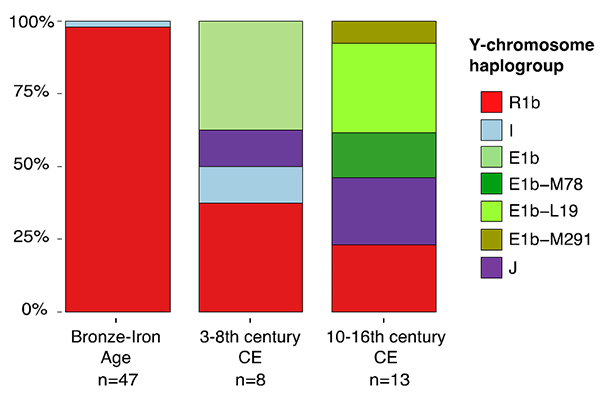
Does this continued influx of Y-DNA haplogroups in Iberia with different cultures represent permanent changes in language? Are, therefore, modern Iberian languages derived from Lusitanian, Sorothaptic/Celtic, Greek, Phoenician, East or West Germanic, Hebrew, Berber, or Arabic languages? Obviously not. Same with Italy (see the recent preprint on modern Italians by Raveane et al. 2018), with France, with Germany, or with Greece.
If that happens in European regions with a known ancient history, why would the recent expansions and bottlenecks of R1b in modern Basques (or N1c around the Baltic, or R1a in Slavs) in the Middle Ages represent an ancestral language surviving into modern times?
Indo-Iranians
If something is clear from Narasimhan, Patterson, et al. (2018), is that we know finally the timing of the introduction and expansion of R1a-Z645 lineages among Indo-Iranians.
We could already propose since 2015 that a slow admixture happened in the steppes, based on archaeological finds, due to settlement elites dominating over common peoples, coupled with the known Uralic linguistic traits of Indo-Iranian (and known Indo-Iranian influence on Finno-Ugric) – as I did in the first version of the Indo-European demic diffusion model.
The new huge sampling of Sintashta – combined with that of Catacomb, Poltavka, Potapovka, Andronovo, and Srubna – shows quite clearly how this long-term admixture process between Uralic peoples and Indo-Iranians happened between forest-steppe CWC (mainly Abashevo) and steppe groups. The situation is not different from that of Iberia ca. 2500-2000 BC; from Narasimhan, Patterson, et al. (2018):
We combined the newly reported data from Kamennyi Ambar 5 with previously reported data from the Sintashta 5 individuals (10). We observed a main cluster of Sintashta individuals that was similar to Srubnaya, Potapovka, and Andronovo in being well modeled as a mixture of Yamnaya-related and Anatolian Neolithic (European agriculturalist-related) ancestry.
Even with such few words referring to one of the most important data in the paper about what happened in the steppes, Wang et al. (2018) help us understand what really happened with this simplistic concept of “steppe ancestry” regarding Yamna vs. Corded Ware differences:
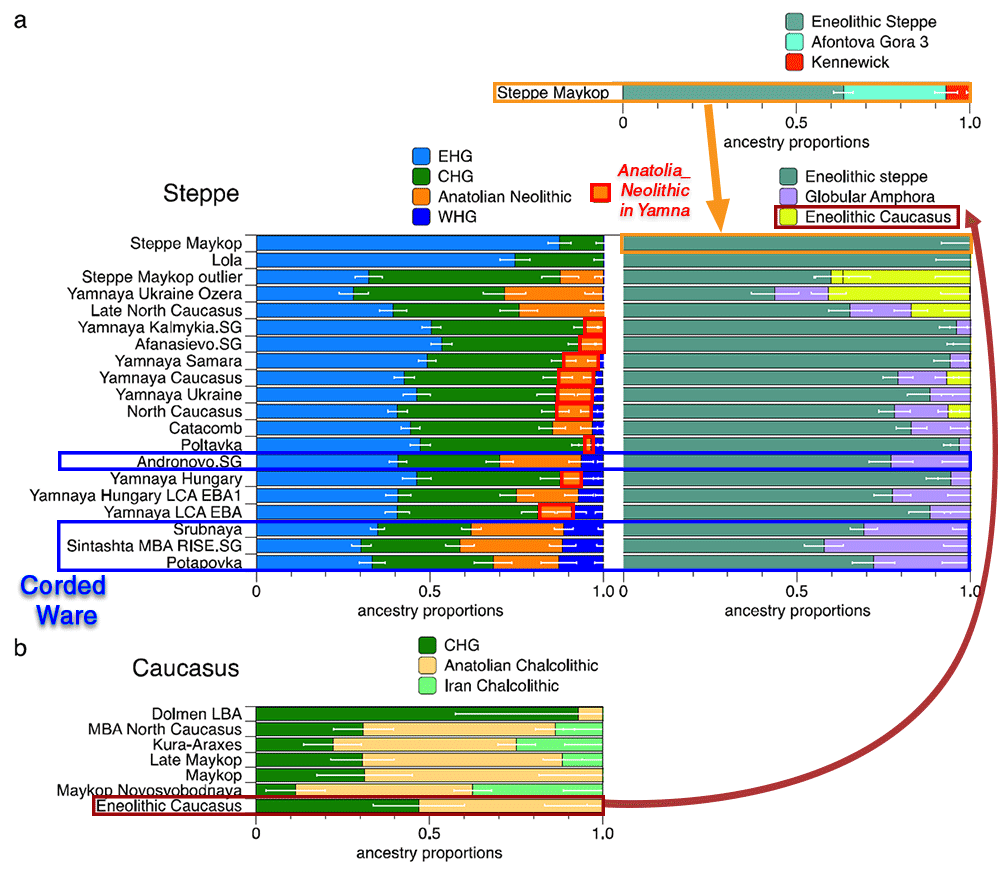
As with Iberia (or any prehistoric region), the details of how exactly this language change happened are not evident, but we only need a plausible explanation coupled with archaeology and linguistics. Poltavka, Potapovka, and Sintashta samples – like the few available Iberian ones ca. 2500-2000 BC – offer a good picture of the cohabitation of R1b-L23 (mainly Z2103) and R1a-Z645 (mainly Z93+): a glimpse at the likely presence of R1a-Z93 within settlements – which must have evolved as the dominant elites – in a society where the majority of the population was initially formed by nomad herders (probably most R1b-Z2103), who were usually buried outside of the main settlements.
Will the upcoming Narasimhan, Patterson et al. (2019) deal with this problem of how R1a-M417 replaced R1b-M269, and how the so-called “Steppe_MLBA” (i.e. Corded Ware) ancestry admixed with “Steppe_EMBA” (i.e. Yamnaya) ancestry in the steppes, and which one of their languages survived in the region (that is, the same the Reich Lab has done with Iberia)? Not likely. The ‘genetic wars’ in Iberia deal with haplogroup R1b-P312, and how it was neither ‘native’ nor associated with Basques and non-Indo-European peoples in general. The ‘genetic wars’ in South Asia are concerned with the steppe origin of R1a, to prove that it is not a ‘native’ haplogroup to India, and thus neither are Indo-Aryan languages. To each region a politically correct account of genetic finds, with enough care not to fully dismiss national myths, it seems.
NOTE. Funnily enough, these ‘genetic wars’ are the making of geneticists since the 1990s and 2000s, so we are still in the midst of mostly internal wars caused by what they write. Just as genetic papers of the 2020s will most likely be a reaction to what they are writing right now about “steppe ancestry” and R1a. You won’t find much change to the linguistic reconstruction in this whole period, except for the most multicolored glottochronological proposals…
The first author of the paper has engaged, as far as I could see in Twitter, in dialogue with Hindu nationalists who try to dismiss the arrival of steppe ancestry and R1a into South Asia as inconclusive (to support the potential origin of Sanskrit millennia ago in the Indus Valley Civilization). How can geneticists deal with the real problem here (the original ethnolinguistic group expanding with Corded Ware), when they have to fend off anti-steppists from Europe and Asia? How can they do it, when they themselves are part of the same societies that demand a politically correct presentation of data?
This is how the data on the most likely Indo-Iranian-speaking region should be presented in an ideal world, where – as in the Iberia paper – geneticists would look closely to the Volga-Ural region to discover what happened with Proto-Indo-Iranians from their earliest to their latest stage, instead of constantly looking for sites close to the Indus Valley to demonstrate who knows what about modern Indian culture:
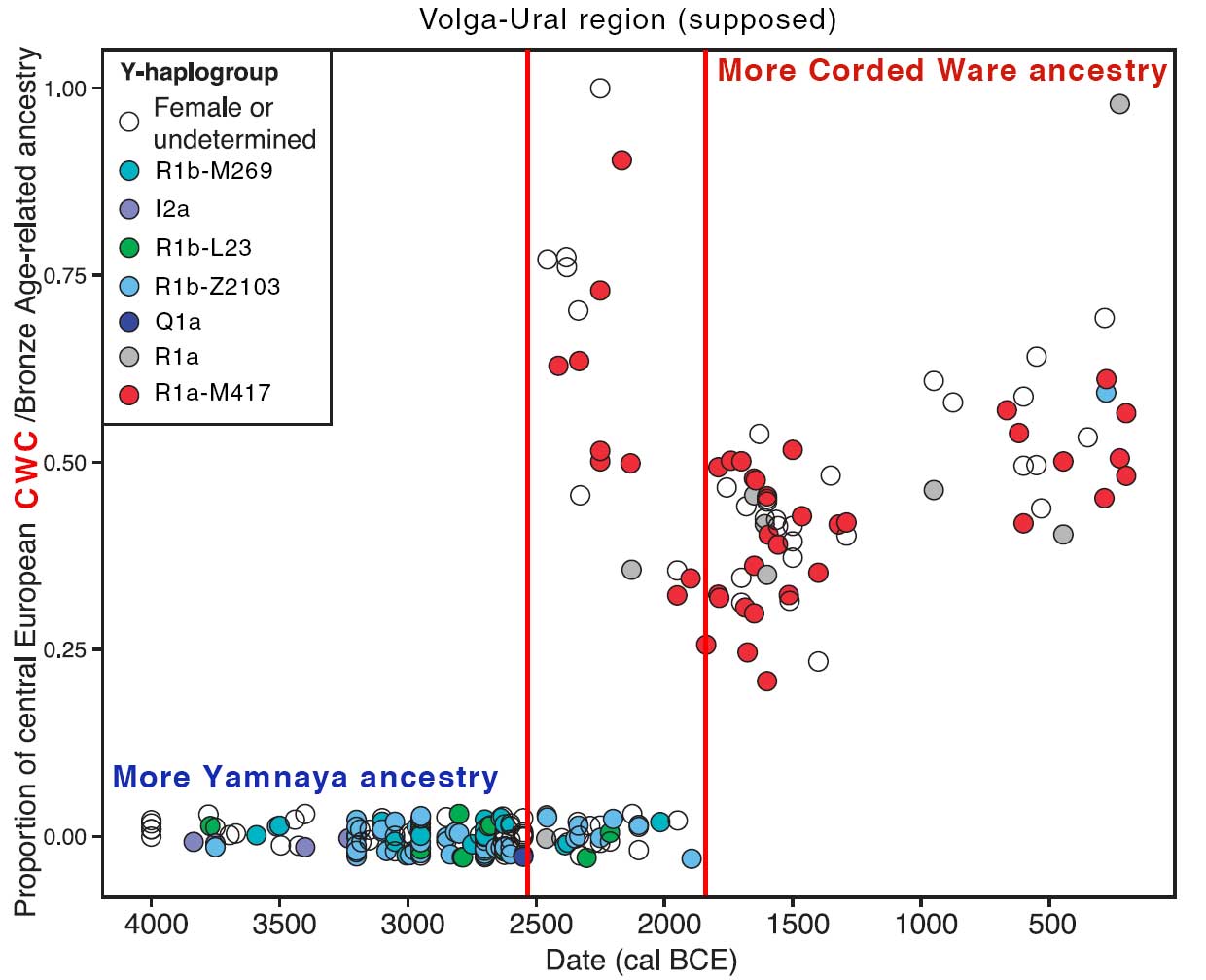
Now try and tell Hindu nationalists that Sanskrit expanded from an Early Bronze Age steppe community of R1b-rich nomadic herders that spoke Pre-Indo-Iranian, which was dominated and eventually (genetically) mostly replaced by elite Uralic-speaking R1a peoples from the Russian forest, hence the known phonetic (and some morphological) traits that remained. Good luck with the Europhobic shitstorm ahead..
Balto-Slavic
Iberian cultures, already with a majority of R1b lineages, show a clear northward expansion over previously Urnfield-like groups of north-east Iberia and Mediterranean France (which we now know probably represent the migration of Celts from central Europe). Similarly, Eastern Balts already under a majority of R1a lineages expanded likely into the Baltic region at the same time as the outlier from Turlojiškė (ca. 1075 BC), which represents the first obvious contacts of central-east Europe with the Baltic.
Iberia shows a more recent influx of central and eastern Mediterranean peoples, one of which eventually succeeded in imposing their language in Western Europe: Romans were possibly associated mainly with R1b-U152, apart from many other lineages. Proto-Slavs probably expanded later than Celts, too, connected to the disintegration of the Lusatian culture, and they were at some point associated with R1a-M458 and R1a-Z280(xZ92) lineages, apart from others already found in Early Slavs.
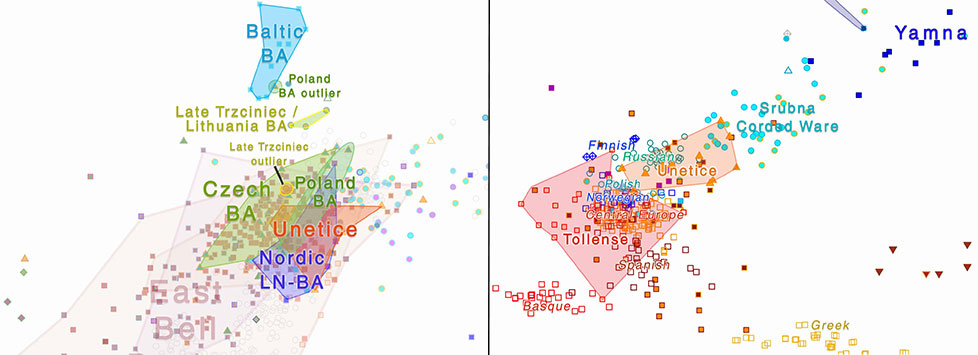
This parallel between Iberia and eastern Europe is no coincidence: as Europe entered the Bronze Age, chiefdom-based systems became common, and thus the connection of ancestry or haplogroups with ethnolinguistic groups became weaker.
What happened earlier (and who may represent the Pre-Balto-Slavic community) will be clearer when we have enough eastern European samples, but basically we will be able to depict this admixture of NWIE-speaking BBC-derived peoples with Uralic-speaking CWC-derived groups (since Uralic is known to have strongly influenced Balto-Slavic), similar to the admixture found in Indo-Iranians, more or less like this:
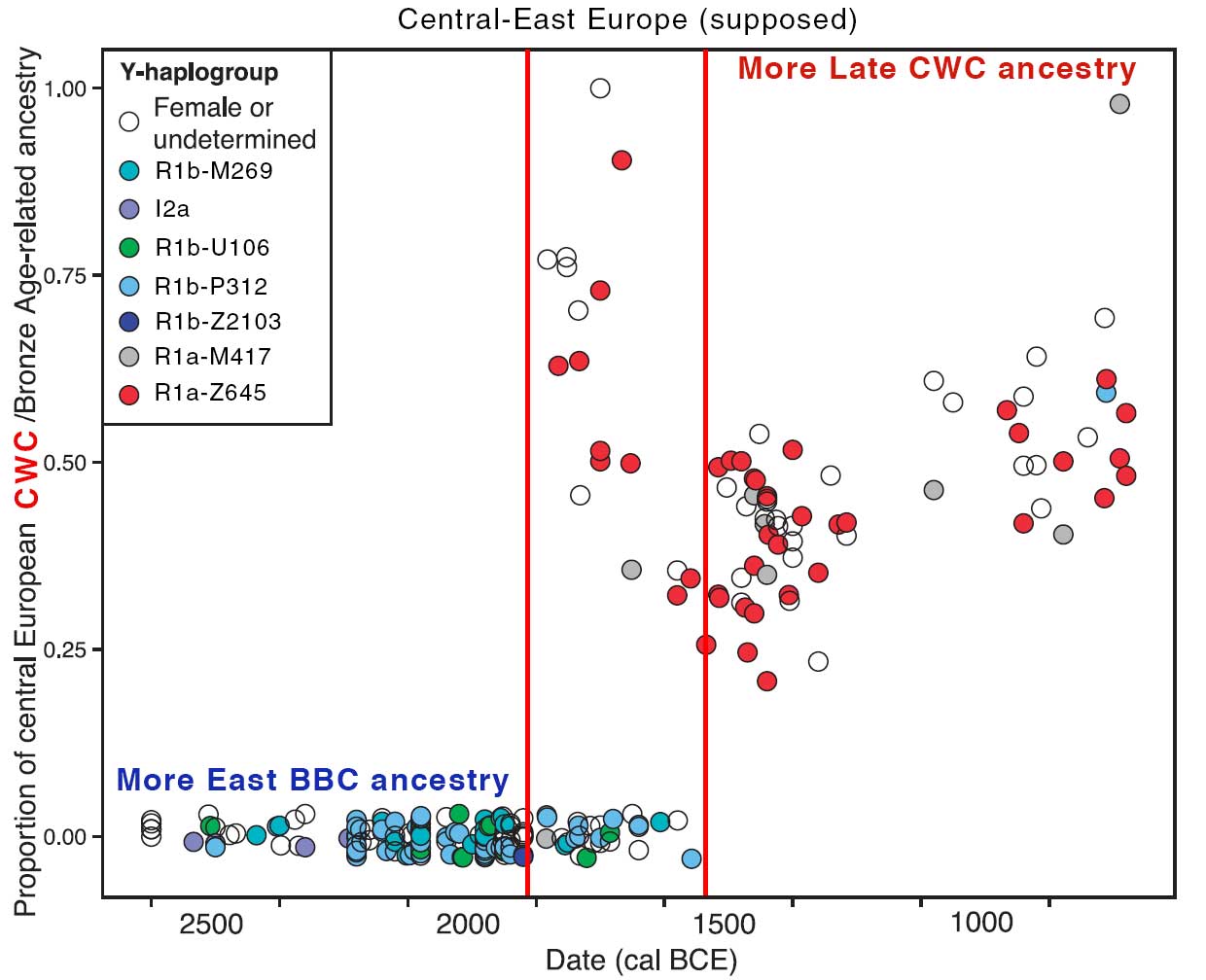
The Early Scythian period marked a still stronger chiefdom-based system which promoted the creation of alliances and federation-like groups, with an earlier representation of the system expanding from north-eastern Europe around the Baltic Sea, precisely during the spread of Akozino warrior-traders (in turn related to the Scythian influence in the forest-steppes), who are the most likely ancestors of most N1c-V29 lineages among modern Germanic, Balto-Slavic, and Volga-Finnic peoples.
Modern haplogroup+language = ancient ones?
It is not difficult to realize, then, that the complex modern genetic picture in Eastern Europe and around the Urals, and also in South Asia (like that of the Aegean or Anatolia) is similar to the Iron Age / medieval Iberian one, and that following modern R1a as an Indo-European marker just because some modern Indo-European-speaking groups showed it was always a flawed methodology; as flawed as following R1b for ancient Vasconic groups, or N1c for ancient Uralic groups.
Why people would argue that haplogroups mean continuity (e.g. R1b with Basques, N1c with Finns, R1a with Slavs, etc.) may be understood, if one lives still in the 2000s. Just like why one would argue that Corded Ware is Indo-European, because of Gimbutas’ huge influence since the 1960s with her myth of “Kurgan peoples”. Not many denied these haplogroup associations, because there was no reason to do it, and those who did usually aligned with a defense of descriptive archaeology.
However, it is a growing paradox that some people interested in genetics today would now, after the Iberian paper, need to:
- accept that ancient Iberians and probably Aquitanians (each from different regions, and probably from different “Basque-Iberian dialects” in the Chalcolithic, if both were actually related) show eventually expansions with R1b-L23, the haplogroup most obviously associated with expanding Indo-Europeans;
- acknowledge that modern Iberians have many different lineages derived from prehistoric or historic peoples (Celts, Phoenicians, Greeks, Romans, Jews, Goths, Berbers, Arabs), which have undergone different bottlenecks, the last ones during the Reconquista, but none of their languages have survived;
- realize that a similar picture is to be found everywhere in central and western Europe since the first proto-historic records, with language replacement in spite of genetic continuity, such as the British Isles (and R1b-L21 continuity) after the arrival of Celts, Romans, Anglo-Saxons, Vikings, or Normans;
- but, at the same time, continue blindly asserting that haplogroup R1a + “steppe ancestry” represent some kind of supernatural combination which must show continuity with their modern Indo-Iranian or Balto-Slavic language from time immemorial.
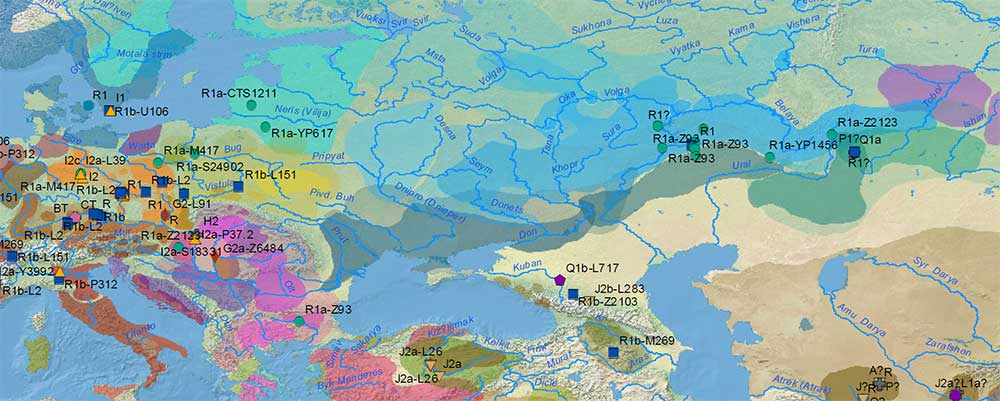
Behave, pretty please
The ‘conservative’ message espoused by some geneticists and amateur genealogists here is basically as follows:
- Let’s not rush to new theories that contradict the 2000s, lest some people get offended by granddaddy not being these pure whatever wherever as they believed, and let’s wait some 5, 10, or 20 years, as long as necessary – to see if some corner of the Yamna culture shows R1a, or some region in north-eastern Europe shows N1c, or some Atlantic Chalcolithic sample shows R1b – to challenge our preferred theories, if we actually need to challenge anything at all, because it hurts too much.
- Just don’t let many of these genetic genealogists or academics of our time be unhappy, pretty please with sugar on top, and let them slowly adapt to reality with more and more pet theories to fit everything together (past theories + present data), so maybe when all of them are gone, within 50 or 70 years, society can smoothly begin to move on and propose something closer to reality, but always as politically correct as possible for the next generations.
- For starters, let’s discuss now (yet again) that Bell Beakers may not have been Indo-European at all, despite showing (unlike Corded Ware) clearly Yamna male lineages and ancestry, because then Corded Ware and R1a could not have been Indo-European and that’s terrible, so maybe Bell Beakers are too brachycephalic to speak Indo-European or something, or they were stopped by the Fearsome Tisza River, or they are not pure Dutch Single Grave in The South hence not Indo-European, or whatever, and that’s why Iron Age Iberians or Etruscans show non-Indo-European languages. That’s not disrespectful to the history of certain peoples, of course not, but talking about the evident R1a-Uralic connection is, because this is The South, not The North, and respect works differently there.
- Just don’t talk about how Slavs and Balts enter history more than 1,500 years later than Indo-European peoples in Western and Southern Europe, including Iberia, and assume a heroic continuity of Balts and Slavs as pure R1a ‘steppe-like’ peoples dominating over thousands of kms. in the Baltic, Fennoscandia, eastern Europe, and northern Asia for 5,000 years, with multiple Balto-Slavs-over-Balto-Slavs migrations, because these absolute units of Indo-European peoples were a trip and a half. They are the Asterix and Obelix of white Indo-European prehistory.
- Perhaps in the meantime we can also invent some new glottochronological dialectal scheme that fits the expansion of Sredni Stog/Corded Ware with (Germano-?)Indo-Slavonic separated earlier than any other Late PIE dialect; and Finno-Volgaic later than any other Uralic dialect, in the Middle Ages, with N1c.
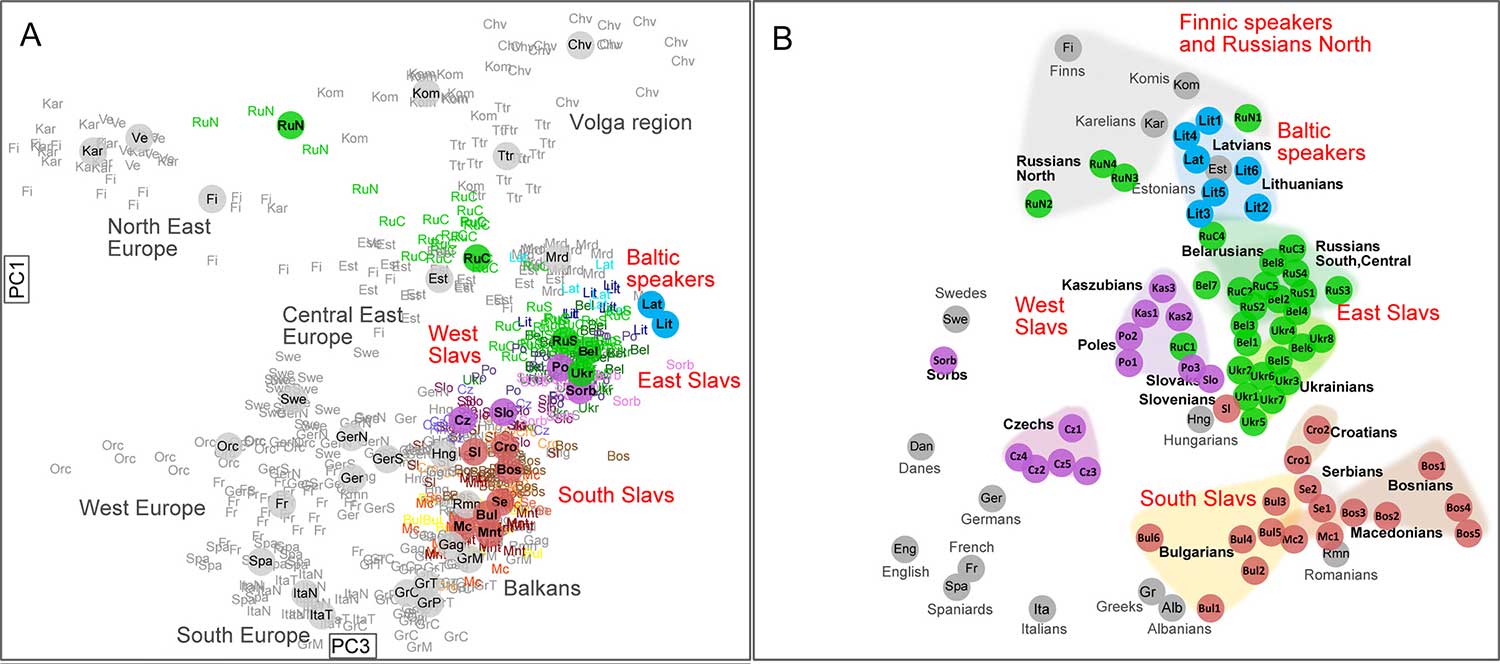
To sum up: Iberia, Italy, France, the British Isles, central Europe, the Balkans, the Aegean, or Anatolia, all these territories can have a complex history of periodic admixture and language replacement everywhere, but some peoples appearing later than all others in the historical record (viz. Basques or Slavs) apparently cannot, because that would be shameful for their national or ethnic myths, and these should be respected.
Ignorance of the own past as a blank canvas to be filled in with stupid ethnolinguistic continuity, turned into something valuable that should not be challenged. Ethnonationalist-like reasoning proper of the 19th century. How can our times be called ‘modern’ when this kind of magical thinking is still prevalent, even among supposedly well-educated people?
Related
- The genetic and cultural barrier of the Pontic-Caspian steppe – forest-steppe ecotone
- The uneasy relationship between Archaeology and Ancient Genomics
- Dzudzuana, Sidelkino, and the Caucasus contribution to the Pontic-Caspian steppe
- Steppe and Caucasus Eneolithic: the new keystones of the EHG-CHG-ANE ancestry in steppe groups
- On the origin of haplogroup R1b-L51 in late Repin / early Yamna settlers
- On the origin and spread of haplogroup R1a-Z645 from eastern Europe
- Corded Ware culture origins: The Final Frontier
- Sredni Stog, Proto-Corded Ware, and their “steppe admixture”
- Kurgan origins and expansion with Khvalynsk-Novodanilovka chieftains
- About Scepters, Horses, and War: on Khvalynsk migrants in the Caucasus and the Danube
- The Caucasus a genetic and cultural barrier; Yamna dominated by R1b-M269; Yamna settlers in Hungary cluster with Yamna
- The concept of “Outlier” in Human Ancestry (III): Late Neolithic samples from the Baltic region and origins of the Corded Ware culture
- Consequences of Damgaard et al. 2018 (II): The late Khvalynsk migration waves with R1b-L23 lineages
- On the potential origin of Caucasus hunter-gatherer ancestry in Eneolithic steppe cultures
- North Pontic steppe Eneolithic cultures, and an alternative Indo-Slavonic model
- New Ukraine Eneolithic sample from late Sredni Stog, near homeland of the Corded Ware culture
- The renewed ‘Kurgan model’ of Kristian Kristiansen and the Danish school: “The Indo-European Corded Ware Theory”